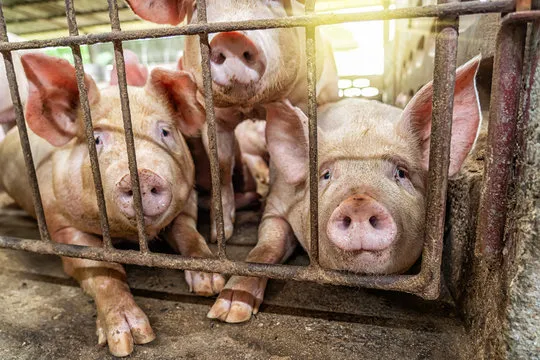Hello dear friends, I am still in the business of writing about animals, infections that affect animals, and how we can salvage the situation, thanks to steemsocial for giving me the opportunity to share this gained knowledge over here. Today, I will share knowledge about, African Swine Fever.
African swine fever is a viral disease, capable of existing in domestic pigs as well as wild pigs, is a highly contagious disease by the way, with a high rate of mortality that can get as high as 100%. The virus is highly resistant, and it can survive on boots, wheels, clothes as well as other materials, this means that humans play a great role in the spread of this virus. It can also comfortably survive in different pork products like sausages, ham, or bacon.

www.pexels.com
The good thing is, African swine fever, cannot be transmitted from pigs to humans, regardless of eating contaminated pork meat or through physical contact. It is very unclear why the virus cannot be transmitted to humans, but what we know is that, the virus targets macrophages and monocytes in swine cells, it does this for easy entry and multiplication, even if the identity of the cellular receptors that are targeted by the virus for host cell entry is not yet known.
African swine fever is endemic in sub-Saharan Africa. In Europe, it has been endemic in Sardinia for several decades. In 2007 outbreaks occurred in Georgia, Armenia, Azerbaijan and the European part of Russia, Ukraine, and Belarus.Ref
There is a current increase in the number of farmers diving into the pig business, as it remains a great source of household income in so many countries, unfortunately, the African swine fever has destroyed so many farms putting a large loophole in people's livelihood. I don't eat pork meat, but pork meat consumers have been accounted to take around 35% of the global meat intake, therefore the disease is a serious one that needs to be handled seriously.
How infection happens.
Certainly, since pigs are not born with the infection, there has to be a way of contact, and we need to know how it happens. Getting infected with African swine fever can happen through one or more of these ways;
Pigs are known to be highly social animals, they are more healthy and happy when they are together with their kin or kith, therefore limiting the spread of the virus could be quite difficult. Transmitting the disease occurs through contact with feces, contact with bodily fluids, or contact with contaminated carcasses of the infected pigs. The virus can persist for 5 months in a boned meat product stored at about 4 degrees Celcius, in an asymptomatic infection, however, the virus can last for an extended time in the blood or in the tissue.
Feeding pigs with meat or meat products of an infected animal, from the likes of waste, swill feed of an infected animal.
When pigs are bitten by infected ticks, they can also contract the infection.
Contact with infected pigs.
Close contact with any material that is already infected- the materials could be clothes, shoes, or even a car.

stock.adobe.com
The incubation period for African swine diseases often varies, but takes around 5-15 days, the clinical signs may either be chronic, sub-acute or existing in an acute form. Clinical signs to watch out for in an infected animal include one or more of these;
- Loss of appetite.
- Abortions, still birt and weak litters.
- Internal bleeding
- Visible hemorrhages on the flanks and the ears.
- Eyes that are gummed up.
- Difficulty with coughing and breathing.
- Weakness and inability to stand.
- Vomiting.
- Diarrhea (not in all common cases).
- Having red or dark skin, majorly the ears and the snout.
In order to prevent the spread of this infection, farmers have a strong role to play by putting up serious biosecurity measures. Since there are currently no vaccines or therapeutics for the prevention or control of African Swine Fever, this is certainly due to its highly complex viral nature, it has a large genome as well as numerous genes involved in immune evasion.
Create room for highly strict biosecurity, giving room for only highly needed visitors to get into your farm, ensure that, they put on very clean or better still, disposable cloth and footwear, while they properly wash their hands before getting in. Also, vehicles and equipment used on the farm or that enter the farm, have to be appropriately disinfected.
Those who may have been in contact with other pigs should not be allowed contact with your pigs without proper protection. Pork products should not be brought into the farm by unauthorized external sources, waste products should be disposed of appropriately.
While sourcing semen and pigs, ensure they are of great health status.
Regardless of the fact that the virus has been existing for a very long time, detected almost a century ago, there is currently no commercial vaccine or any form of treatment for the ASF virus. The pigs that survive the stage of mild infection usually after 4-19 days of incubation, can naturally shed the virus for 70 days, in order to prevent the spread of the virus, the animal has to be immediately quarantined or slaughtered.
Conclusion.
African swine disease is a very dangerous disease with a high mortality rate and does not have any efficient treatment method. Having a great impact on the economy, health, and social well-being. Early detection of the virus in affected animals and isolating the animal to prevent huge outbreaks is extremely important.